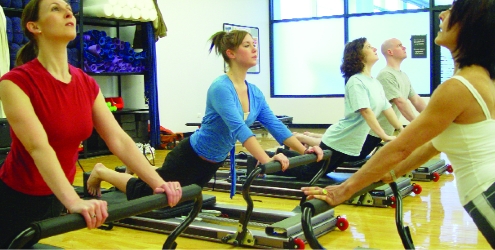Educating for Wholeness
DePaul University helps prepare students for fitness careers that cover all the corners.

The physical education program at DePaul University in Chicago offers students a choice of two majors: teaching or fitness management and wellness. The latter concentration is unique in that it prepares students for a career managing or developing fitness programs in small businesses, large corporations or recreational settings. Christopher Arterberry, MS, is the associate director of DePaul’s fitness and wellness department of campus recreation; he interacts with future fitness professionals on an ongoing basis. He also helps manage the in-house group fitness training program at the recreation center. Arterberry sees the future of fitness as being centered on the concept of wholeness, and he helps educate young people about the importance of approaching deconditioned people with an eye toward total wellness.
How long have you been involved with this program? What kind of changes have you seen during your tenure?
I’ve been at DePaul for nearly 3 years and have been involved in DePaul’s physical education program for about 2 years as a campus partner and part-time adjunct faculty. The primary change I’ve observed has been that students are slowly becoming more proactive in seeking out opportunities to get involved in fitness and recreation, regardless of their major.
What are the main highlights of the curriculum? How do these factors prepare students for a career in the fitness industry?
I think a main highlight of the academic curriculum is that students are able to choose between a teaching track or a fitness management track on their way to a degree in physical education, which means that their courses better prepare them for their specific career goals. The main highlight of our in-house group fitness training “curriculum” is the combination of theory and practical skills; the former is covered in a weekly meeting of the entire group of students, and the latter is covered in a separate weekly meeting in small groups, which are organized by the students’ primary format of interest.
How do you grade students or define program completion?
Students are graded on both content knowledge and practical skills in various academic courses. Our training program also includes both content knowledge and practical skills, and evaluation focuses on practical application.
How much of the program is practical (hands-on), and how much is theory?
I would say that the practical/theoretical split is about 60/40.
What are the major obstacles or challenges for your program? And for the graduates?
The major challenge for our training program is that it’s not offered as a for-credit course in the physical education curriculum. First, this means that a student’s expenses are paid out-of-pocket rather than being included in their tuition package. Second, while most students take the program seriously, when they’re crunched for time and juggling noncredit classes with credit classes, the program suffers because the students focus on the credit-granting classes.
What motivates today’s young adults to enter group fitness? What attracts them into your program?
I think most students who enter group exercise do so because they enjoy it as participants and they want the intrinsic and extrinsic rewards of helping others and making money doing it. It’s a lot more fun than some other part-time jobs that may be options for them.
Do you have a mentorship or placement system set up for students to transition into?
With the addition of another full-time fitness professional on our staff, we’re going to be able to pursue things that we haven’t been able to pursue in the past, including an internal mentoring program for new group fitness instructors and personal trainers.
What do you think needs to happen in the industry to ensure the success of younger fitness professionals?
I think there are two things the industry needs to address regarding younger professionals. First, we need to do a better job of taking advantage of the various talents of these professionals, regardless of whether they’re part-time or full-time. To restrict them to the confines of a single position, when they’re interested in doing more, is a mistake. Second, the industry is going to have to figure out away to make full-time positions more financially attractive. There are still way too many companies that offer these professionals subpar compensation, and companies that can’t find a solution are going to experience high turnover. More than any other generation, these new graduates have grown up in an age of consumerism and are used to living a particular lifestyle. I don’t think they’ll be very patient with a job that doesn’t allow them to live that lifestyle on their own, right away.
SIDEBAR: Management Miffs
- Subbing. “More and more people just send a mass e-mail to the staff when they need a class covered, but then don’t follow up with phone calls when needed. I think one downfall of current technology is that some people over-rely on it and aren’t as comfortable with personal contact, such as phone calls.”
- Consistency. “Balancing consistency with individuality across classes within a given format [is difficult].”
- CECs. “[We are] unable to provide affordable continuing education credits (CECs) to staff. We can’t pay instructors as much as some commercial facilities, and while our facility and overall work environment offset that somewhat, we’d like to be able to provide affordable CECs to staff.”
- New Classes. “Resisting pressure to add yoga and Pilates classes to the schedule [is a struggle]. These formats are currently on our instructional schedule, which is registration- and fee-based, whereas our group exercise schedule is drop-in and included with facility access. We’re not willing to absorb the higher payroll costs of these two formats that, while popular, serve only a small percentage of our users. We have very similar classes under different names on our schedule, but people sometimes don’t make the connection, even after attending those classes and doing similar exercises.”




